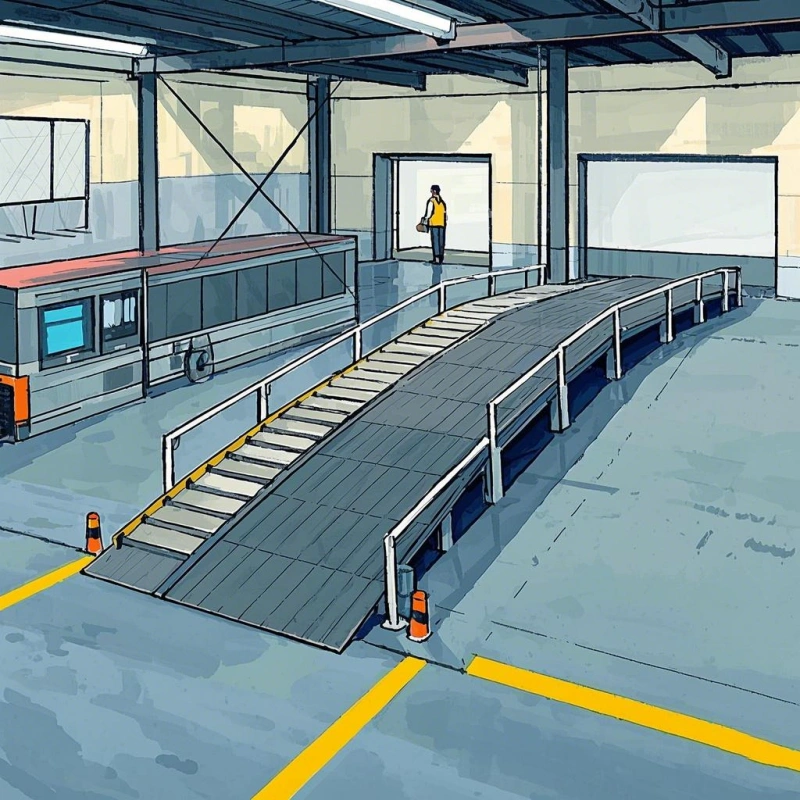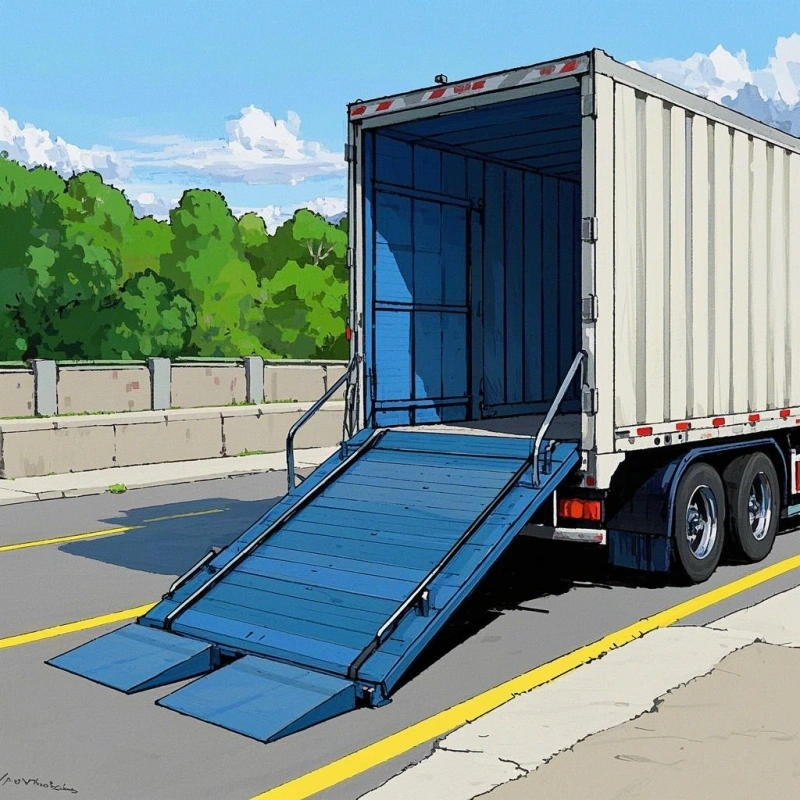Loading ramps are critical components in various industries, including logistics, manufacturing, and transportation. They facilitate the efficient movement of goods between different levels, such as from a warehouse to a truck or from a production line to a storage area. The design of loading ramps must adhere to specific standards to ensure safety, efficiency, and durability. This article delves into the key design standards for loading ramps, covering aspects such as structural integrity, safety features, accessibility, and compliance with regulatory requirements.
1. Structural Integrity
1.1 Material Selection
The choice of materials for loading ramps is paramount to their structural integrity. Common materials include steel, aluminum, and concrete. Each material has its advantages and disadvantages:
Steel: Known for its strength and durability, steel is often used in heavy-duty applications. However, it is susceptible to corrosion if not properly treated.
Aluminum: Lightweight and resistant to corrosion, aluminum is ideal for portable ramps. However, it may not be as strong as steel.
Concrete: Extremely durable and suitable for permanent installations, concrete ramps are often used in industrial settings. However, they are not portable and require significant construction effort.
1.2 Load Capacity
Loading ramps must be designed to handle specific load capacities, which are determined by the types of vehicles and equipment that will use them. The design should account for:
Static Load: The weight of the vehicle or equipment when stationary.
Dynamic Load: The additional force exerted when the vehicle or equipment is moving.
Impact Load: The sudden force that occurs when a vehicle or equipment impacts the ramp.
Design standards typically require a safety factor, often 1.5 to 2 times the maximum expected load, to ensure the ramp can handle unexpected stresses.
1.3 Slope and Gradient
The slope of a loading ramp is a critical factor in its design. A steep slope can make it difficult for vehicles and equipment to ascend or descend safely, while a gentle slope may require more space. Common standards recommend:
Maximum Slope: Typically, a slope of 10-15% is considered safe for most vehicles. For manual handling equipment like pallet jacks, a slope of less than 10% is preferable.
Transition Zones: Smooth transitions at the top and bottom of the ramp are essential to prevent vehicles from getting stuck or tipping over.

2. Safety Features
2.1 Non-Slip Surfaces
To prevent accidents, loading ramps must have non-slip surfaces. This can be achieved through:
Textured Surfaces: Adding texture to the ramp surface increases friction and reduces the risk of slipping.
Coatings: Applying anti-slip coatings or materials like rubber can enhance traction.
Drainage: Proper drainage systems should be in place to prevent water accumulation, which can make surfaces slippery.
2.2 Guardrails and Barriers
Guardrails and barriers are essential for preventing vehicles and equipment from falling off the ramp. Design standards typically require:
Height: Guardrails should be at least 42 inches high to prevent falls.
Strength: They must be able to withstand a certain amount of force, often specified in local building codes.
Visibility: Reflective materials or markings can improve visibility, especially in low-light conditions.
2.3 Lighting and Signage
Proper lighting and signage are crucial for safe operation, especially in areas with high traffic or during nighttime operations. Standards may include:
Illumination: Adequate lighting should be provided to ensure visibility of the ramp and surrounding areas.
Signage: Clear signs indicating the ramp's load capacity, slope, and any other relevant information should be prominently displayed.
3. Accessibility
3.1 Width and Clearance
The width of the loading ramp must accommodate the largest vehicles or equipment that will use it. Design standards often specify:
Minimum Width: Typically, a width of 8-12 feet is recommended for most industrial applications.
Clearance: Adequate clearance on both sides of the ramp is necessary to prevent accidents and ensure smooth operation.
3.2 Maneuvering Space
Sufficient space should be provided at the top and bottom of the ramp for vehicles and equipment to maneuver safely. This includes:
Turning Radius: The space required for vehicles to turn around without difficulty.
Approach and Departure Angles: The angles at which vehicles approach and depart the ramp should be designed to prevent scraping or tipping.
4. Compliance with Regulatory Requirements
4.1 Local Building Codes
Loading ramps must comply with local building codes, which may vary by region. These codes often specify:
Permit Requirements: Obtaining the necessary permits before construction begins.
Inspection: Regular inspections to ensure ongoing compliance with safety standards.
4.2 Occupational Safety and Health Administration (OSHA) Standards
In the United States, OSHA provides guidelines for loading ramps, including:
Fall Protection: Requirements for guardrails, toe boards, and other fall protection measures.
Load Ratings: Clear labeling of the ramp's load capacity to prevent overloading.
4.3 Americans with Disabilities Act (ADA) Compliance
For ramps that may be used by individuals with disabilities, ADA compliance is essential. This includes:
Slope: A maximum slope of 1:12 (8.33%) for ramps used by individuals with disabilities.
Handrails: Handrails on both sides of the ramp, with specific height and grip requirements.
Landings: Level landings at the top and bottom of the ramp, as well as at intervals along the ramp.
5. Maintenance and Inspection
5.1 Regular Inspections
Regular inspections are crucial to ensure the ongoing safety and functionality of loading ramps. Inspections should cover:
Structural Integrity: Checking for cracks, corrosion, or other signs of wear and tear.
Safety Features: Ensuring that guardrails, non-slip surfaces, and lighting are in good condition.
Load Capacity: Verifying that the ramp can still handle its designated load capacity.
5.2 Maintenance Practices
Proper maintenance practices can extend the lifespan of loading ramps and prevent accidents. These practices include:
Cleaning: Regularly cleaning the ramp to remove debris and prevent slipping.
Repairs: Promptly addressing any damage or wear to prevent further deterioration.
Lubrication: For ramps with moving parts, regular lubrication can prevent jamming and ensure smooth operation.
Conclusion
Loading ramp design standards are essential for ensuring the safety, efficiency, and durability of these critical structures. By adhering to standards related to structural integrity, safety features, accessibility, and regulatory compliance, designers and engineers can create loading ramps that meet the needs of various industries while minimizing the risk of accidents and injuries. Regular maintenance and inspections further ensure that loading ramps remain safe and functional over time. As industries continue to evolve, so too will the standards for loading ramp design, ensuring that they remain effective in meeting the demands of modern logistics and transportation.

833.webp)
824.webp)
322.webp)